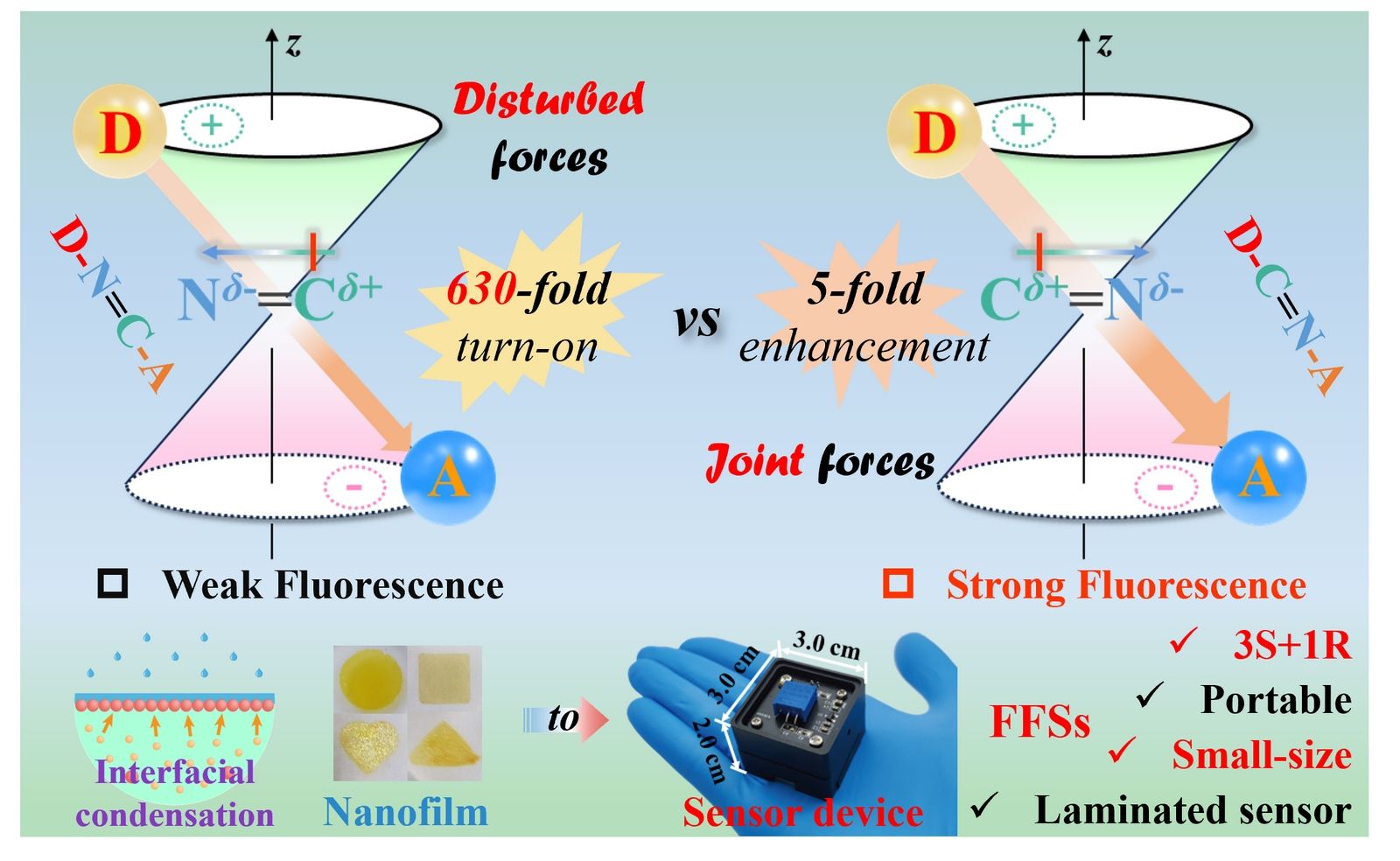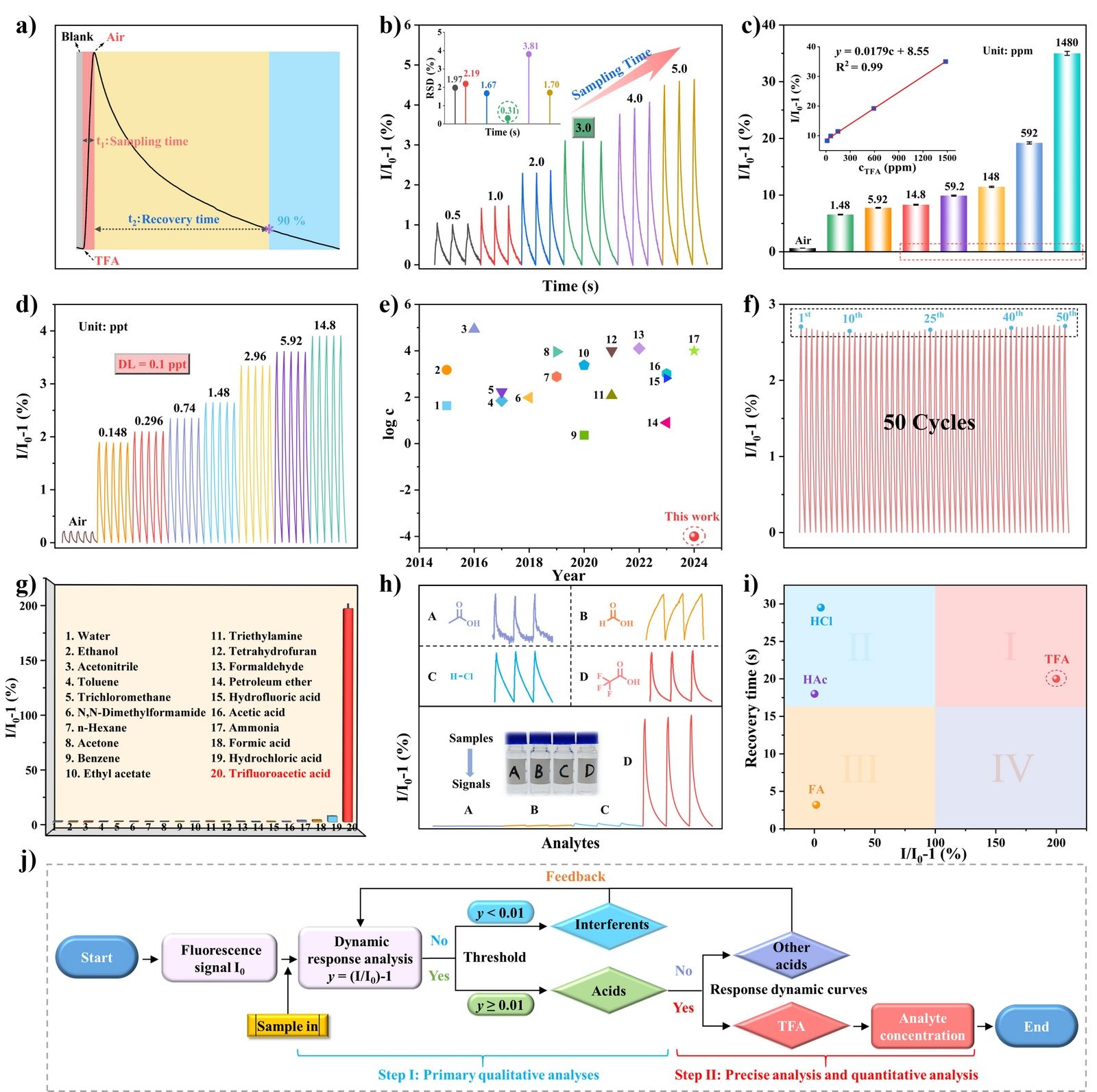
Jiang Feng, Haixia Chang, Xingtong Zhou, Shouxin Zhang,* Liping Ding,* Taihong Liu,* and Yu Fang. ACS Appl. Mater. Interfaces, 2025, DOI: 10.1021/acsami.5c00028

Photoluminescence efficiencies of covalent organic frameworks (COFs) are significantly restricted by the electron delocalization and charge transfer among the conjugated skeletons. Aiming to evaluate the inherent effect of imine sequences on the photophysical properties of the generated frameworks, two nanofilms (denoted as the nanofilms #1 and #2) were prepared based on the air-liquid interfacially confined dynamic condensation strategy using the same building skeletons, tetraphenylethylene (TPE) and benzo[c][1,2,5]thiadiazole (BT). To be noted, the AIEgen TPE and BT acted as the D and A groups, respectively, and the imine group could be functioned as an emission mediator and a recognition site for sensing applications. The nanofilms’ properties were systematically characterized and comprehensively investigated using the steady-state optical techniques and ultrafast transient absorption.
The nanofilm #1 displayed a steady-state absorption maximum around 410 nm corresponding to the π-π* transitions. Additional strong and narrow short-wavelength absorption bands were also found around 320 nm. Specifically, the nanofilm #2 featured the absorption maximum around 430 nm. The spectral red-shift (Δλ ~ 20 nm) reflected the slightly extended π-delocalization of D-A conjugation as well as the enhanced π-π transition in the nanofilm #2 featuring the D-C=N-A sequence. The increased optical energy gaps from ~ 2.23 eV for the nanofilm #1 to that of ~ 2.35 eV for the nanofilm #2 supported efficient ICT in the joint D-C=N-A sequence. It suggested that the joint D-C=N-A sequence produced a little stronger electron transfer capability than the contrastive D-N=C-A sequence as expected. The ICT and fluorescence properties of these nanofilms were also seriously influenced by the imine sequences. As reported, the plausible PET and cis-trans isomerization process of C=N effects generally resulted in the non-fluorescent or less-emissive characteristics.
The distinct dipole moment orientations of imine linkages involved in the π-delocalization of conjugated donor-acceptor systems diversely. They also played critical roles in affecting the fluorescence turn-on sensing of the obtained nanofilms for gaseous trifluoroacetic acid (TFA). The joint donor-C=N-acceptor sequence in the nanofilm #2 resulted in relatively stronger fluorescence originally than that of the nanofilm #1 featuring the disturbed donor-N=C-acceptor sequence. While after blowing trace TFA, the latter nanofilm #1 possessed prominent fluorescence enhancement and obviously color visualization. Comparative transient absorption observations and theoretical calculations elucidated the effective manipulation of the ICT efficiencies among the imine-linked functional skeletons.
With the help of a laminated fluorescent sensor, a compact sensing platform was further integrated using the optimized nanofilm #1. It exhibited good selectivity, excellent reversibility (≥ 50 recycles), extraordinary detection limit (~ 0.1 ppt), and rapid recovery process to gaseous TFA. In-depth analysis of the recovery time on the sensing curves of TFA and other acid interferences, a clear discrimination among them could be conducted. Our findings provide the valuable optimizations of π-linkages in COFs and reliable fluorescent film sensors for monitoring toxic and hazardous gases.

Figure 1. (a) Schematic diagrams of the constitutional isomerism of imine linkages with the distinct dipole moment orientations. (b) Frameworks of the nanofilm #1 featuring the disturbed D-N=C-A sequence and the nanofilm #2 featuring the joint D-C=N-A sequence. (c) Schematic illustration for preparing the nanofilms via the air-liquid interfacially confined dynamic condensation strategy.

Figure 2. Sensing and discrimination performances of the nanofilms to gaseous TFA based on the home-made sensing platform.
First Author: Feng Jiang, Master’s candidate, Shaanxi Normal University
Correspondence Authors: A/Prof. Liu Taihong, Prof. Ding Liping, Shaanxi Normal University; A/Prof. Zhang Shouxin, State Key Laboratory of NBC Protection for Civilian
Full Text Link: https://doi.org/10.1021/acsami.5c00028